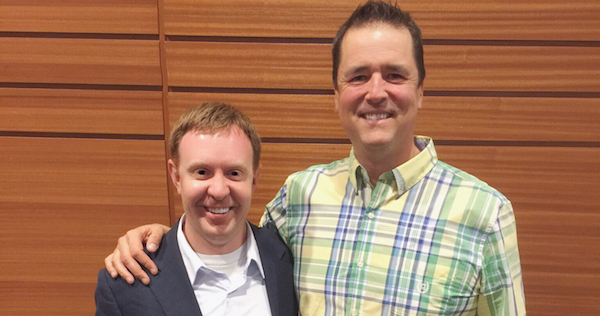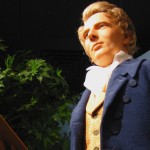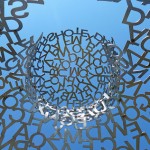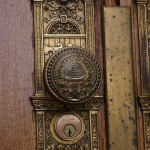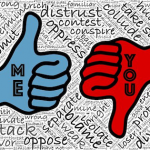PATRICK Q. MASON, Chair of Mormon Studies and Associate Professor of Religion at Claremont Graduate University: Hi John! I’m excited about this new blog. Let’s start off with some introductions. Tell me a little bit about yourself, for those who don’t know who John Dehlin is!
JOHN DEHLIN, psychologist and social activist, post-Mormon, founder of Mormon Stories Podcast: Thanks Patrick! It’s an honor to be invited to this conversation.
I come from pioneer ancestry through the Benson and Parkinson lines. My grandmother was a cousin of Latter-day Saints Prophet Ezra Taft Benson. I was “born in the covenant” and raised primarily in Texas (Dallas and Houston/Katy). The church meant everything to me as a child and young man. I was heavily active and believing during my childhood and adolescence. 4 years of seminary. Scripture chase. Youth conferences. Road shows. The whole bit. Being Mormon was the #1 way in which I identified myself, even though I was active in student government, varsity basketball and more. This was somewhat challenging in a heavily Baptist town where The God Makers was shown annually as a part of the “Mormons and Other Cults” series.
After a year at BYU, I served a mission in the Guatemala City North mission (‘88-’90). I served as a zone leader and branch president twice while there. I DEARLY LOVED my mission, but became exposed to unsavory baptism practices by mission leadership (baptizing children after soccer games, etc…over 700 baptisms per month for my mission…some companionships baptized over 40 in a month…see here for details), and was disappointed to learn that my mission president was supportive of these practices. This was one of the first “cracks” in my orthodox testimony.
I returned to BYU after my mission and married in the Washington D.C. temple. I went to work for companies like Bain, Arthur Andersen, and Microsoft. While working for Microsoft I was called as a seminary teacher (around 2001-2002) and began studying LDS church history in depth (D. Michael Quinn, Fawn Brodie, Grant Palmer, Simon Southerton, etc.) and had a full-on crisis of faith before there were Internet resources to support such a thing. I floundered for several years…struggling with deep depression…but writings from men like Gene England, Leonard Arrington, and Lowell Bennion helped pull me out of the depression. I voluntarily left Microsoft in 2004 determined to help others with similar struggles, and started Mormon Stories Podcast in 2005. The purpose of Mormon Stories Podcast (at least in the early years) was to help others discuss difficult Mormon topics in a safe and healthy environment, with the hope that they could remain active in the LDS church.
In 2010 I realized that many more resources were needed than just Mormon Stories podcast, and so I started a 501c3 non-profit called the Open Stories Foundation (OSF). The OSF has created several additional web sites/podcasts — and many of them continue to be valuable resources for helping people stay constructively engaged with Mormonism including Mormon Matters podcast, A Thoughtful Faith podcast, Mormon Mental Health podcast, StayLDS, and Mormon Transitions podcast.
Over time the information I learned from the podcast made it harder and harder for me to remain a member in good standing. Over time, I became more and more troubled with various issues (LGBT issues, feminism, depression and divorces due to faith crisis, etc.) – I became more vocal (my TEDx talk on being a Mormon LGBT ally) and sometimes critical of LDS church leaders — and the podcasts became more and more influential. All of this led led to my excommunication in 2015.
Since then I have focused my efforts on helping unorthodox LDS church members transition away from orthodoxy in healthy and constructive ways. Oh…and along the way I completed a Ph.D. in Clinical and Counseling Psychology from Utah State University – focusing on the nexus of mental health and religion. You can see a list of my research publications here. Most of my academic publications deal with either anxiety disorders (scrupulosity or religious OCD) or the LGBT Mormon experience (e.g., sexual orientation change efforts, mixed-orientation marriages, celibacy).
How about you, Patrick? Tell us a bit about your background.
Patrick: That’s great, John. Nice to hear more about your background and what makes you “tick.” And congrats on the Ph.D. — definitely worth mentioning!
I was raised in the suburbs of Salt Lake City in a very active Mormon family. My dad was bishop during my teenage years, etc. Like you, I had a pretty “typical” LDS upbringing, with active involvement in the church’s youth programs. I went on a mission to Seattle — apparently because someone in Salt Lake was inspired enough to know that I’m horrible at learning languages. My mission was foundational for me in the way that it is for many others.
I graduated from BYU with a degree in history. One of the most important classes I took was “Mormonism and the American Experience,” taught by Dr. David Whittaker. He had worked with Leonard Arrington over the years, and gave us a straightforward presentation of Mormon history, “warts and all.” It was the first time I heard about Joseph Smith using seer stones and stuff like that. I think it helped me a lot to have that information come in a BYU classroom — there was no sense that the institutional church was hiding anything, since I was getting it at the church’s flagship university.
After graduating from BYU, I went to the University of Notre Dame, where I earned an MA in international peace studies and a PhD in history, focusing on American religious history. I didn’t plan on focusing my career on Mormonism, but what I thought would be a small part of my dissertation turned out to be the best part, which became my first book, on 19th-century anti-Mormon violence. (It’s called The Mormon Menace, for anyone who wants to rush right out and buy it.) That helped qualify me for my current job as the Howard W. Hunter Chair of Mormon Studies and associate professor of religion at Claremont Graduate University.
I had always intended on pursuing a purely academic path in my scholarship on Mormonism and American religion. But given everything I was seeing in the church the past few years, in particular the pain of people leaving the church and those who were watching them leave, I decided to enter the fray, somewhat against my natural instincts. Late last year I published Planted: Belief and Belonging in an Age of Doubt, which tries to address some of the major issues facing people, not so much with a detailed rehearsal of answers but rather providing a different paradigm to think about church history, prophets, and in general just ministering empathetically toward those who have questions or doubts.
I should also note that I am very active in the LDS Church as a member of the Claremont 1st Ward, where my wife and I have the best calling in the church, as Gospel Doctrine teachers.
That’s probably more than enough by way of intro. John, can you say a few words about what you want to accomplish through this blog?
John: Sure Patrick. Before I do, I have to mention your amazing FairMormon talk that you delivered a few weeks back. Readers – If you haven’t read or listened to it…it’s epic!
My goals with this blog conversation would be the following:
- To model ways to improve the discourse between believers and non-believers. Too often on the Mormon internet we have apologetics/academics on one side and Progressive/Post-Mormonism on the other — and rarely do the these “camps” engage one another constructively. I would love to find ways to bridge this gap and model a more healing, constructive discourse.
- I believe that far too many false stereotypes exist surrounding both orthodox Mormons and liberal/post-Mormons. In my view, orthodox Mormons are too often characterized as “willfully blind” or as “dupes” — and I know that these are not fair characterizations. Similarly, I know that far too often liberal/post-Mormons are characterized as “weak” or as “wanting to sin,” or are dismissed as “angry.” I would like to dig a little deeper on both sides to see if we can reach a better, deeper, richer understanding.
- Finally, I have witnessed far too much unnecessary suffering over the past 15 years — depression, estrangement within families, divorce, suicide — due to differences and misunderstandings around the LDS faith. I will do anything I can to help build understanding and empathy, alleviate suffering, and prevent families from being unnecessarily divided.
Those are my main goals. How about you?
Patrick: Those goals very much echo mine. A recent Time Magazine cover story was about the “culture of hate” on the internet, and we certainly see a lot of that in online conversations about Mormonism. There’s so much misunderstanding, both innocent and intentional, and people are so quick to make others “offenders for a word.” I sincerely believe that as children of God, or as members of the human family, we need to do our utmost to build bridges of understanding, compassion, and empathy. The consequences otherwise are what we’re seeing too much of in our culture, and in Mormonism, including those who have disaffiliated from the church.
So with all due respect to Donald Trump, I’m far more interested in building bridges than walls. I don’t believe that means giving up your deeply held convictions. I think we can learn a lot from each other, and hopefully be better Christians, or Mormons, or humans, or whatever, by listening to and valuing other people’s experiences.
Those who have chosen to remain in the LDS Church and those who have chosen to leave (or in some cases been forced out) have generally had competing monologues. I’m interested to see what a dialogue might look like, and to see what surprises might ensue — because human beings, when presented three-dimensionally, are always more interesting and surprising than the stock characters we make of them.
The conversation continues: How Do We Know What We Know?

